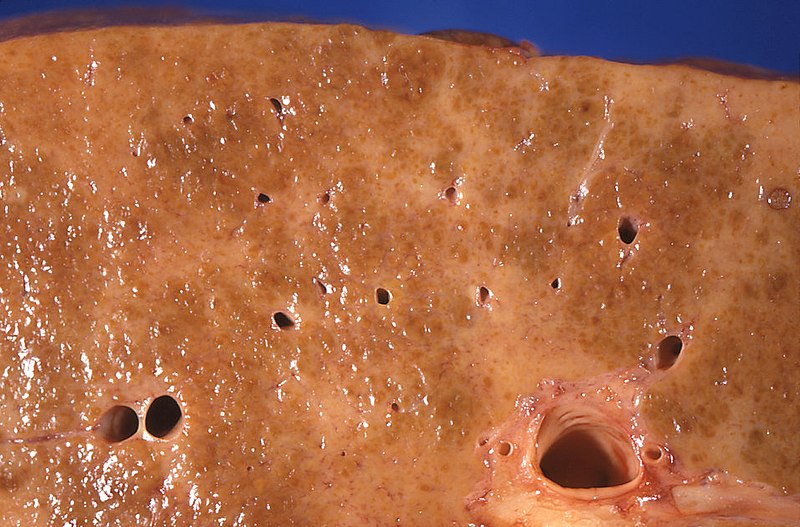Playlist
Show Playlist
Hide Playlist
Hepatorenal Syndrome with Case
-
Slides Gastroenterology 13 Liver Pt3 End Stage Liver Disease.pdf
-
Reference List Gastroenterology.pdf
-
Download Lecture Overview
00:02 Now let's move on to our next case. 00:05 A 53-year-old woman with a history of cryptogenic cirrhosis with ascites is hospitalized for altered mental status. 00:12 She has been taking her furosemide, spironolactone and lactulose as directed. 00:17 She's been having 5-7 bowel movements a day. 00:21 Vitals are normal. 00:22 She is disoriented. 00:24 Physical exam is notable for asterixis and abdominal distention with a fluid wave. 00:29 Her mucus membranes are dry. 00:31 Lab studies are notable for BUN of 42 (U/L)and serum creatinine 2.5 (mg/dL). 00:36 A urinalysis is normal and renal ultrasound is unremarkable. 00:40 Blood culture results are sent and pending. 00:44 Her diuretics are discontinued. 00:46 So what is the best next step in managing her acute kidney injury? So, she has altered mental status in a patient with decompensated cirrhosis. 00:58 She does have signs of hepatic encephalopathy with her disorientation, her asterixis and her dehydration. 01:05 And she has an evidence of acute kidney injury with her azotemia. 01:12 So, let's discuss hepatorenal syndrome. 01:16 This is a particular type of acute kidney injury in a patrient with liver disease due to portal hypertension which then leads to a decline in the renal function. 01:25 This is a complicated diagnosis to make and is a diagnosis of exclusion. 01:31 How this forms is first beginning with portal hypertension. 01:36 Portal hypertension leads to vasodilatation of the splanchnic vessels which then leads to effective arterial hypovolemia and then because the kidneys are sensing less blood flow, they then activate the renin-angiotensin-aldosterone system or the RAAS system. 01:55 This leads to increased renal absorption of sodium and water which in turn leads to buildup of ascites And on the other hand, this can also lead to renal vasoconstriction which leads to acute kidney injury or hepatorenal syndrome. 02:14 So the diagnostic criteria are quite strict for hepatorenal syndrome. 02:19 I must admit this is a very difficult diagnosis to make because you have to really exclude anything else that could lead to an AKI. 02:26 So it's defined by an increase in serum creatinine. 02:31 You must have no response to a fluid challenge with albumin. 02:35 They must have no other factors that can lead to an AKI. 02:39 So no shock, medications known to be toxic to the kidneys, the urinalysis must be normal, they must not have any proteinuria and you must also make sure the patient has no chronic kidney disease or obstruction on the ultrasound,. 02:53 both of which may lead to their AKI. 02:56 So, just remember that hepatorenal syndrome is a diagnosis of exclusion. 03:00 So you must exclude everything else that could potentially lead to this picture. 03:06 How we manage it depends on the pathophysiology. 03:10 So if you recall that renal perfusion decreases in the development of HRS then you now know that to counteract that, we want to increase perfusion to the kidneys. 03:20 We do that by giving vasoconstricting medications like terlipressin or octreotide, midodrine or norepinephrine if the patient is critically ill. 03:29 And we also try to increase blood flow to the kidneys by increasing the effective blood volume so that's by colloid resuscitation with albumin. 03:41 And if you have done all of these things and the patient continues to have kidney failure, you then consider a referral for both a liver and kidney transplant evaluation. 03:51 So now let's go back to our case. 03:54 53-year-old woman with new onset altered mental status. 03:57 She has decompensated cirrhosis, signs of hepatic encephalopathy on her exam and her labs are concerning for a new AKI with azotemia. 04:07 So now we are asked, what is the best next step to confirm the diagnosis? So, recall that her urinalysis and ultrasound were normal which helps us rule out other causes of acute kidney injury. 04:20 The next step to confirm the diagnosis would be to perform a fluid challenge with albumin to rule out a prerenal AKI.
About the Lecture
The lecture Hepatorenal Syndrome with Case by Kelley Chuang, MD is from the course Disorders of the Hepatobiliary Tract.
Included Quiz Questions
Which of the following is part of the diagnostic criteria for hepatorenal syndrome?
- No response to fluid challenge with albumin
- Decreased serum creatinine
- Proteinuria
- Shock
- CKD
Which of the following is the first step in managing ascites patients with acute kidney injury?
- Colloid resuscitation with albumin
- Vasodilators
- Liver transplantation
- Kidney transplantation
- Diuretics
Customer reviews
5,0 of 5 stars
| 5 Stars |
|
5 |
| 4 Stars |
|
0 |
| 3 Stars |
|
0 |
| 2 Stars |
|
0 |
| 1 Star |
|
0 |





